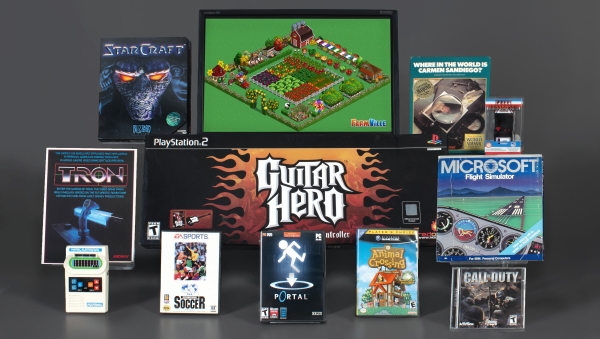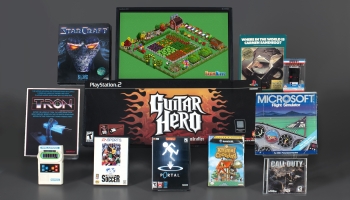
The Strong Museum’s World Video Game Hall of Fame has announced they will enshrine this year’s inductees on May 6th. We’ll know which games comprise the Class of 2021 in just 47 days, but it’s safe to say that one of the clear frontrunners was identified exactly 365 days ago.
It was on March 20th of 2020 that Nintendo released Animal Crossing: New Horizons, and in the year that followed, it transformed the way a lot of people think about video games. So it wasn’t much of a surprise that the franchise’s GameCube debut, Animal Crossing, was chosen as a finalist in 2021.
It’ll be joined by six other first-time finalists vying for a spot in the Hall of Fame this year. That lists includes 1977’s Mattel Football, which introduced the world to handheld gaming, as well as 2009’s FarmVille, a game that minted an entirely new generation of “gamers” on Facebook. There’s also Blizzard’s StarCraft, which further popularized the RTS genre in 1998 and helped birth the esports scene. Finally, three games from 1982 (Microsoft Flight Simulator, Namco’s Pole Position, and Midway’s Tron) impressed the Hall of Fame’s internal committee, which chose to highlight the variety found in some of the industry’s earliest efforts.
These games will be competing against a handful of returning finalists that are getting another crack at the Hall of Fame in 2021, including Activision’s Call of Duty, EA Sports’s FIFA International Soccer, Harmonix’s Guitar Hero, Valve’s Portal, and Broderbund’s Where in the World Is Carmen Sandiego?
The members of the Hall of Fame’s International Selection Advisory Committee are the final decisionmakers on which of these titles will become part of this year’s induction class, but the public can once again have a voice in the proceedings by visiting WorldVideoGameHallOfFame.org between now and March 25. The three games that receive the most votes in an online poll will be submitted as the “Player’s Choice” ballot when the Committee meets later this Spring.
You can learn more about this year’s finalists after the break, and be sure to tune in to the virtual ceremony celebrating this year’s inductees into the World Video Game Hall of Fame on May 6 at 10:30 AM (Eastern Time).
Meet the 2021 World Video Game Hall of Fame Finalists
Animal Crossing: Nintendo’s Animal Crossing debuted in 2001 and found mass appeal with its open-ended social simulation and leisurely gameplay. Players took on the role of a human moving into a village filled with anthropomorphic animals. The game had no specific objective, giving players the freedom to complete activities and collect objects as they liked. The mellow gameplay proved a success with casual and advanced gamers alike, and it bred numerous sequels. The game’s latest installment for the Nintendo Switch proved a huge hit during the pandemic isolation of 2020, breaking the record for the most digital downloads of a console game in a single month.
Call of Duty: Released by Infinity Ward/Activision in 2003, Call of Duty helped popularize the cinematic, first-person war genre. Set during World War II, the game combined fast-pace action with a deep, rich narrative. Its squad-based, multiplayer mode provided a reason for gamers to return again and again. Call of Duty continues to generate sequels and spinoffs, and it was the catalyst for one of the best-selling electronic game franchises of all time with more than 300 million total units sold.
FarmVille: This free-to-play game from developer Zynga changed the video game industry and how people play online with its debut in 2009. Millions created their first social media account just to play this simple Flash game on Facebook. The basic mechanics of the game—plow, plant, and harvest to expand your agrarian business—charmed a wide range of social media users and made “gamers” out of people of all ages. In 2010, a year after launch, FarmVille boasted nearly 83 million active users per month, and it was succeeded by several sequels.
FIFA International Soccer: FIFA International Soccer was not the first sports simulation video game—nor even the first one about soccer—but it is the most popular sports game franchise of all time, with sales continually bolstered by annual releases from publisher Electronic Arts. First launched in 1993, the game garnered worldwide success and launched a franchise that has sold more than 325 million games by 2021.
Guitar Hero: Launched in 2005, Harmonix’s Guitar Hero challenged players to unleash their inner rock star by following on-screen notes and strumming to the beat of popular music on a plastic guitar. Its wide appeal, licensed music, and social gameplay spawned other similar titles, including the popular Rock Band. Activision, which acquired the game’s rights, released versions of Guitar Hero for nearly every platform, including home consoles, computers, and handheld and mobile devices. The Guitar Hero series has sold more than 25 million units worldwide and more than 60 million tracks, earning more than $2 billion.
Mattel Football: Released in 1977, Mattel Electronics Football was the first blockbuster handheld electronic game and introduced millions to portable gaming. Its popularity generated an entire segment of electronic toys and games and paved the way for handheld systems like Nintendo’s Game Boy and today’s mobile devices. In 2010, Time magazine named it one of its “All Time 100 Gadgets.”
Microsoft Flight Simulator: For nearly four decades, Microsoft Flight Simulator has provided millions of players endless hours of game play by providing highly realistic but intuitive recreations of real-life airplanes. Its simple premise and accessible content disguises the advanced programming that has made it so successful. Since its launch in 1982, the game has been regularly updated and remains the most popular, longest lasting, and most influential flying sim of all time.
Pole Position: First hitting arcades in 1982, Pole Position motored to the top of the racing game genre with its realistic gameplay. The game came in two configurations, and both included a steering wheel, gear shift, and gas pedal, thrusting players into the driver’s seat. Created by Namco and distributed in North America by Atari, the game became the highest grossing arcade game of 1983 in the United States. Atari ported the game to console systems, and it has been rereleased numerous times in the past three decades. It inspired many of the 3D racing games that followed.
Portal: Released by Valve Corporation in 2007 as part of a five-game compilation entitled The Orange Box, Portal became an unexpected breakout, often receiving more critical acclaim than the other four titles combined. Viewed as a major advance in puzzle games, Portal provided a unique gaming experience accompanied by witty dialogue, an ever-twisting plotline, and unforgettable characters. It sold a respectable four million copies, but it was most lauded for its technical and design achievements.
StarCraft: California-based developer Blizzard Entertainment took the real-time strategy genre to new heights in 1998 with the debut of StarCraft. The single-player mode of the immersive, science-fiction game proved popular, but the multiplayer mode, which included a ladder ranking system, turned it into the largest e-sports title of its day. Starcraft won multiple Game of the Year Awards, and generated its own lines of novels, graphic novels, licensed toys, clothing, and gaming accessors.
Tron: Midway’s Tron was the first arcade game paired with a Hollywood movie. When it entered the arcade in 1982, its combination of challenging gameplay, innovative cabinet design, and unique control grip made it a hit with gamers. The film entered theaters two months later, riding on the back of the game’s buzz, but the game ultimately outshone the movie, earning more than $60 million to the film’s $33 million in the U.S.. The film and game inspired a new film version in 2010—which spurred a new wave of console, PC, and mobile games—proving its cultural relevance even decades later.
Where in the World is Carmen Sandiego?: Released by Brøderbund in 1995, Where in the World is Carmen Sandiego? spawned one of the best-selling “edutainment” franchises, combining education and entertainment. Designed for the first generation of graphic-enabled personal computers, the title made learning world geography fun for millions of students as they searched for the whereabouts of the mysterious Carmen Sandiego. The game, which launched several sequels, also inspired a hit show on American Public Broadcasting in the 1990s and an animated series on Netflix (2019-2021)—helping propel Carmen Sandiego and her world-traveling ways into the cultural zeitgeist.

